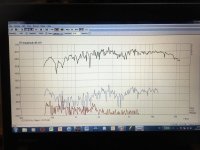For some of my B&C drivers, 2 different suspensions are available. The differences are subtly visible in measurements, but clearly audible.
Attachments
Last edited:
Somewhere in the "Geddes on Waveguides" thread, Dr. Geddes refers to compression drivers as "commodities".
This is an original replacement 3" diaphragm for a Celestion 2" exit driver.
Look for the differences.
This is an original replacement 3" diaphragm for a Celestion 2" exit driver.
Look for the differences.
Attachments
Last edited:
Alternatives
In this thread BMS 4592 vs Radian Beryllium, there's some background info on popular - and obtainable - large format drivers.
There are quite a few drivers on the market which - at least on paper - are more or less capable of the performance claimed for the Axi2050.
The BMS Coax drivers are probably first to come to mind. However, I doubt these are good enough for critical listening. Many professionals share this opinion.
The design is overly complicated and the indispensable crossover doesn't help either to blend the mids with the highs. The peak in the response around 18-20kHz is just one of the issues.
Besides, these drivers are very expensive - especially the HE editions - and very sensible to characteristics of the attached horn.
In conclusion: not really worth their price for domestic use.
The fact these are widely available on the used market, makes one wonder.
JBL D2430K, I am quite sure these sound better than the BMS Coax drivers, but cannot be used below 500Hz.
Members from the heritageaudio forum prefer some of the older 4" drivers to the 2430K when mounted on the M2 waveguide. Quite surprising, given the fact the old drivers are technically worlds apart from the 2430K and the M2 definitely wasn't designed to be used with the large format drivers.
Many 3" diaphragm drivers are available with either 1.4 or 2" exit from
B&C, Faital-Pro, 18Sound, RCF, Celestion, Fane, Precision Devices, Beyma, Oberton, Radian, Pyle, P-Audio, PRV, Eminence... you name it.
In this thread BMS 4592 vs Radian Beryllium, there's some background info on popular - and obtainable - large format drivers.
There are quite a few drivers on the market which - at least on paper - are more or less capable of the performance claimed for the Axi2050.
The BMS Coax drivers are probably first to come to mind. However, I doubt these are good enough for critical listening. Many professionals share this opinion.
The design is overly complicated and the indispensable crossover doesn't help either to blend the mids with the highs. The peak in the response around 18-20kHz is just one of the issues.
Besides, these drivers are very expensive - especially the HE editions - and very sensible to characteristics of the attached horn.
In conclusion: not really worth their price for domestic use.
The fact these are widely available on the used market, makes one wonder.
JBL D2430K, I am quite sure these sound better than the BMS Coax drivers, but cannot be used below 500Hz.
Members from the heritageaudio forum prefer some of the older 4" drivers to the 2430K when mounted on the M2 waveguide. Quite surprising, given the fact the old drivers are technically worlds apart from the 2430K and the M2 definitely wasn't designed to be used with the large format drivers.
Many 3" diaphragm drivers are available with either 1.4 or 2" exit from
B&C, Faital-Pro, 18Sound, RCF, Celestion, Fane, Precision Devices, Beyma, Oberton, Radian, Pyle, P-Audio, PRV, Eminence... you name it.
Last edited:
The thin mesh "bug screens" are not just for PA environments.A (thin) mesh grille is visible on the published images of the driver. This is a necessity in some PA environments to prevent debris from penetrating the driver's inards.
There are around 100 different species of arthropod (spiders, insects, centipedes, and mites) inhabiting the average home- many of which would be happy to crawl into an unprotected driver entrance and either weave a web, or lay eggs, or die, or some combination of each.
Bugs inside a compression driver are never good for hi-fidelity.
weltersys, I completely agree.
Anybody who has bought used drivers with the horns attached, knows what you mean.
At least, I had to remove insects and spiderwebs from several bugscreens.
Still, some people (Geddes a.o.) remove the screens.
Anybody who has bought used drivers with the horns attached, knows what you mean.
At least, I had to remove insects and spiderwebs from several bugscreens.
Still, some people (Geddes a.o.) remove the screens.
For some of my B&C drivers, 2 different suspensions are available. The differences are subtly visible in measurements, but clearly audible.
What is the difference please ?
A (thin) mesh grille is visible on the published images of the driver. This is a necessity in some PA environments to prevent debris from penetrating the driver's inards.
In my country we have small insects that we call "bestioles d'orange", they are small enough to go between the computers LCD panel and the backlight panel where the space is under 0.1mm.
The Thysanoptera :
Thysanoptera — Wikipedia
Last edited:
What is the difference please ?
Left is a Titanium diaphragm with a Titanium suspension consisting of radial ribs.
Right is a Titanium diaphragm with Mylar suspension.
There are at least 10 compression drivers in which each of these diaphragms can be used.
Each driver does sound different with each diaphragm and 2 randomly picked drivers which the same diaphram will sound (though sometimes maginally) different due to differences in magnet structure, phase plug design, conic exit sections, the addition of ferro fluid, shorting rings etc.
Last edited:
Alternatives II
What Celestion is trying to accomplish is impressive, an admirable technological tour de force.
The question remains if the driver is worth the expected high price, if it becomes available as non-oem driver at all.
Furthermore, it remains to be seen whether the Axi2050 really lives up to expectations > allowing to be used from 300Hz (or lower) up to 20kHz.
At home, the high output such drivers (Axi2050, BMS 4599HE etc.) are capable of, is unnecessary. High sensitivity is desirable though, as is constant coverage.
There's a large group of Beryllium afficionado's within the DIY community.
I don't doubt the merits of Beryllium, but I don't like its toxicity as well as the ridiculous costs of mining and processing the raw material.
However, if you want the best, most refined mid/high driver there's no substitute for Beryllium. Perhaps, until Graphene or other nano materials become applicable in the near future.
Obvious Candidates are Radian 951 BE and 18Sound ND4015BE, both of which are offered for 1400-1500€. For "even" less you could score a used TAD 4001 or 4002, with the expensive risk of damaged diaphragms.
I am not convinced the Radian drivers can be comfortably used from 350-400Hz. Anyway, their output in the top octave leaves much to be desired.
diyaudio member superlian bought a pair ND1415BEs and took some measurements: high pass 400 Hz 48 dB in the active crossover under the measurements and a 47 uF capacitor for protection.
Quite impressive and better than BE JBLs, according to him.
In the third image are Vance Dickason's measurements of the same driver (and probably not the best horn).
What Celestion is trying to accomplish is impressive, an admirable technological tour de force.
The question remains if the driver is worth the expected high price, if it becomes available as non-oem driver at all.
Furthermore, it remains to be seen whether the Axi2050 really lives up to expectations > allowing to be used from 300Hz (or lower) up to 20kHz.
At home, the high output such drivers (Axi2050, BMS 4599HE etc.) are capable of, is unnecessary. High sensitivity is desirable though, as is constant coverage.
There's a large group of Beryllium afficionado's within the DIY community.
I don't doubt the merits of Beryllium, but I don't like its toxicity as well as the ridiculous costs of mining and processing the raw material.
However, if you want the best, most refined mid/high driver there's no substitute for Beryllium. Perhaps, until Graphene or other nano materials become applicable in the near future.
Obvious Candidates are Radian 951 BE and 18Sound ND4015BE, both of which are offered for 1400-1500€. For "even" less you could score a used TAD 4001 or 4002, with the expensive risk of damaged diaphragms.
I am not convinced the Radian drivers can be comfortably used from 350-400Hz. Anyway, their output in the top octave leaves much to be desired.
diyaudio member superlian bought a pair ND1415BEs and took some measurements: high pass 400 Hz 48 dB in the active crossover under the measurements and a 47 uF capacitor for protection.
Quite impressive and better than BE JBLs, according to him.
In the third image are Vance Dickason's measurements of the same driver (and probably not the best horn).
Attachments
Last edited:
Customized versions of these diaphragms have also been developed...
Are in still in development...
ND100-2
Alternatives III
Did I mention RCF?
There's a customized RCF driver behind the wooden waveguide shown earlier.
This is driver is no. 1 on my compression driver list:

Vance Dickason tested it's little brother, the ND950 1.4.
It's worth mentioning both drivers have undergone revisions.
It features a 4" diaphragm with Mylar suspension, does 20 kHz without major breakup issues and is available for about 1/6 of the price for a ND4015BE.
In fact, the RCF's output in the top octave is better than B&C's top of the line DE1090TN, which features a 3" diaphragm.
Members from the pro audio forums subjectively preferred the highs of the RCF to some 3" B&C drivers.
RCF uses this driver in their TT5-A 2-Way fullrange cab from 650Hz, which is quite remarkable considering the rigours of PA.
At home this driver would probably take 350-400Hz in a proper horn, as the impedance peak is unusually low. Much lower than popular
"low frequency champs" like the 2" Faital-Pro's (HF2000, 200, 206 and 20).
An East European manufacturer has tested this driver. Below is the raw response (without EQ, or HPF) of the ND950 2.0 in a custom 60x40 horn.
Did I mention RCF?
There's a customized RCF driver behind the wooden waveguide shown earlier.
This is driver is no. 1 on my compression driver list:

Vance Dickason tested it's little brother, the ND950 1.4.
It's worth mentioning both drivers have undergone revisions.
It features a 4" diaphragm with Mylar suspension, does 20 kHz without major breakup issues and is available for about 1/6 of the price for a ND4015BE.
In fact, the RCF's output in the top octave is better than B&C's top of the line DE1090TN, which features a 3" diaphragm.
Members from the pro audio forums subjectively preferred the highs of the RCF to some 3" B&C drivers.
RCF uses this driver in their TT5-A 2-Way fullrange cab from 650Hz, which is quite remarkable considering the rigours of PA.
At home this driver would probably take 350-400Hz in a proper horn, as the impedance peak is unusually low. Much lower than popular
"low frequency champs" like the 2" Faital-Pro's (HF2000, 200, 206 and 20).
An East European manufacturer has tested this driver. Below is the raw response (without EQ, or HPF) of the ND950 2.0 in a custom 60x40 horn.
Attachments
Last edited:
I can confirm RCF ND950 is a good driver. I'm running mine in dedicated HF950 horn from 600Hz up. I'm satisfied with amount of highs, their smoothness and cleanliness. No pronounced "tube" artefacts after equalization. There are some in ND940 sound though. It's a smaller brother with a bit simpler motor. I heard a recording of ND940 in HF950 horns in a system similar to mine (triamped system, ND940/HF950 + beyma 12mwnd in OB + dual 10" servo subs). The recording was made with a tascam handheld recorder. In ND940 there was a little bit of metallic harshness in sibilants. I don't hear these metallic sounds with my pair of ND950. It may be an artefact of the recorder, but the owner of the system told me he hear these as well.
My previous tweeter was Seas 27TBCD/GB-DXT. RCF is as smooth as Seas but are capable of much higher levels. When Seas starts to distorts, RCF keeps playing clean.
My previous tweeter was Seas 27TBCD/GB-DXT. RCF is as smooth as Seas but are capable of much higher levels. When Seas starts to distorts, RCF keeps playing clean.
Here is my amateur REW measurement of RCF ND950 in HF950 horn from 1.5m in room on axis:
horn-direct.mdat — Yandex.Disk
horn-direct.mdat — Yandex.Disk
Thank you for sharing your experience and measurement, chebum.
This confirms my expectations.
I think the difference in sound quality can probably be attributed to the motor and possibly (less advanced) phase plug design of the ND940.
The smaller exit could also contribute to additional interferences.
If it's not too much of a hassle, it would be nice if you could upload a printscreen of your REW measurement.
This confirms my expectations.
I think the difference in sound quality can probably be attributed to the motor and possibly (less advanced) phase plug design of the ND940.
The smaller exit could also contribute to additional interferences.
If it's not too much of a hassle, it would be nice if you could upload a printscreen of your REW measurement.
Last edited:
Albeit of little statistical significance, or scientific relevance, I like these subjective comparisons, such as between the SEAS dome tweeter - which is also used in the highly praised Kii Three Monitor - and the RCF ND950.
Some people actually do listen to music through their speakers.
A local Magico dealer compared these (yes, there's the RCF and indeed, there's yet another diffraction slot):


favourably to these:

Which is no slouch with its 1-inch Diamond-coated Beryllium-diaphragm tweeter and 9-inch bass drivers with Multi-Wall Carbon, Nanographene cone, 5-inch pure Titanium voice coil and 1/2-inch of linear excursion.
Even though I am completely fed up with "synthetic loudspeakers" like these, there's no denying Magico's excellent engineering.
By the way, the horn speakers with the RCF driver, are still about 10 grand more expensive than the Magicos.
Some people actually do listen to music through their speakers.
A local Magico dealer compared these (yes, there's the RCF and indeed, there's yet another diffraction slot):


favourably to these:

Which is no slouch with its 1-inch Diamond-coated Beryllium-diaphragm tweeter and 9-inch bass drivers with Multi-Wall Carbon, Nanographene cone, 5-inch pure Titanium voice coil and 1/2-inch of linear excursion.
Even though I am completely fed up with "synthetic loudspeakers" like these, there's no denying Magico's excellent engineering.
By the way, the horn speakers with the RCF driver, are still about 10 grand more expensive than the Magicos.
Last edited:
I prefer straightforward, logical and self-evident technological concepts, culminating in well designed and built, as well as reliable and affordable products.
In this respect Thomas Aquinas' expression is apt, which predates Occam's razor ontological parsimony:
"If a thing can be done adequately by means of one, it is superfluous to do it by means of several; for we observe that nature does not employ two instruments [if=""] one suffices."
I guess similar thinking is at the root of any great loudspeaker throughout history, from the days of Western Electric to contemporary designs like the JBL M2/4367.
Hornloading is a method to overcome many issues associated with direct radiating loudspeaker drivers.
Dual diaphragm drivers are another to eliminate the need for separate mid-drivers.
The best loudspeakers I know, have been nearly always 2-ways, either smaller monitors (basically a tweeter with a low-mid woofer) or big hornloaded (coax) speakers.
The premise of the Axi2050 is identical to the BMS coax drivers, by means of a more straightforward and advanced design.[/if]
In this respect Thomas Aquinas' expression is apt, which predates Occam's razor ontological parsimony:
"If a thing can be done adequately by means of one, it is superfluous to do it by means of several; for we observe that nature does not employ two instruments [if=""] one suffices."
I guess similar thinking is at the root of any great loudspeaker throughout history, from the days of Western Electric to contemporary designs like the JBL M2/4367.
Hornloading is a method to overcome many issues associated with direct radiating loudspeaker drivers.
Dual diaphragm drivers are another to eliminate the need for separate mid-drivers.
The best loudspeakers I know, have been nearly always 2-ways, either smaller monitors (basically a tweeter with a low-mid woofer) or big hornloaded (coax) speakers.
The premise of the Axi2050 is identical to the BMS coax drivers, by means of a more straightforward and advanced design.[/if]
Last edited:
FWIW: chebum's REW measurement of the RCF ND950 with the HF950 horn from 1.5m in room on axis.
Attachments
Last edited:
FWIW: chebum's REW measurement of the RCF ND950 with the HF950 horn from 1.5m in room on axis.
20dB/division. 🙁
- Home
- Loudspeakers
- Multi-Way
- New Celestion "AxiPeriodic Driver"


